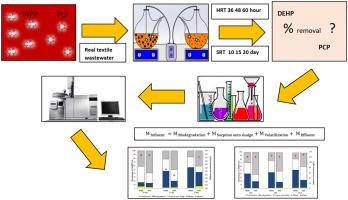Journal of Environmental Chemical Engineering ( IF 7.7 ) Pub Date : 2021-04-04 , DOI: 10.1016/j.jece.2021.105436 E. Yakamercan , A. Aygün

|
This study aimed to examine the effects of hydraulic retention time (HRT) and solid retention time (SRT) on the removal of diethylhexyl phthalate (DEHP) and pentachlorophenol (PCP) from real textile wastewater. Experiments were conducted daily and at different SRTs (10 d, 15 d, and 20 d) and HRTs (36 h, 48 h, and 60 h). The results showed that the optimal HRT and SRT for DEHP removal were 48 h and 20 d, respectively, and the removal efficiency reached 83.27%. Meanwhile, the highest removal efficiency was 75.5% for PCP at an HRT of 60 h and an SRT of 15 d. The addition of biocarriers to the reactor system was intended to facilitate microorganism growth and increase the average removal efficiencies of PCP and DEHP. Short HRTs and SRTs resulted in low micropollutant removal efficiencies. Based on the mass balance calculations, it was determined that biodegradation and sorption onto sludge were the main removal mechanisms for PCP and DEHP. The findings also revealed that using the optimal HRT and SRT is critical to achieve the highest growth of the bacteria responsible for the biodegradation of selected micropollutants. In the biocarrier amended system, biodegradation served and sorption onto sludge contributed to PCP removal. Conversely, the major removal mechanism for DEHP varied depending on the operating conditions. In particular, with increasing SRT, biodegradation became the dominant removal mechanism.
中文翻译:

通过对批次生物膜反应器进行测序,从纺织工业废水中去掉五氯苯酚和邻苯二甲酸二氯己酯
这项研究旨在检查水力停留时间(HRT)和固体停留时间(SRT)对从真实纺织废水中去除邻苯二甲酸二乙基己酯(DEHP)和五氯苯酚(PCP)的影响。每天在不同的SRT(10 d,15 d和20 d)和HRT(36 h,48 h和60 h)进行实验。结果表明,DEHP去除的最佳HRT和SRT分别为48 h和20 d,去除效率达到83.27%。同时,HRT为60时,PCP的最高去除效率为75.5%。 h和SRT为15 d。向反应器系统中添加生物载体的目的是促进微生物生长并提高PCP和DEHP的平均去除效率。较短的HRT和SRT导致微污染物去除效率低。根据质量平衡计算,可以确定生物降解和对污泥的吸附是PCP和DEHP的主要去除机理。研究结果还表明,使用最佳的HRT和SRT对于实现导致选定微污染物生物降解的细菌的最高生长至关重要。在生物载体修正系统中,生物降解起作用并吸附到污泥上有助于PCP的去除。相反,DEHP的主要去除机理因操作条件而异。特别是随着SRT的增加,



























 京公网安备 11010802027423号
京公网安备 11010802027423号